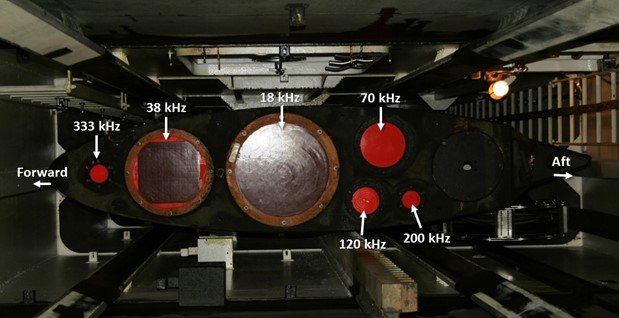Data Acquisition
Survey Equipment
Acoustic Instruments

On Lasker and Shimada, multi-frequency Wideband Transceivers (Simrad EK80 WBTs; Kongsberg) were confgured with split-beam transducers (Simrad ES18, ES38-7, ES70-7C, ES120-7C, ES200-7C, and ES333- 7C on Lasker and ES18, ES38B, ES70-7C, ES120-7C, and ES200-7C on Shimada; Kongsberg). The transducers were mounted on the bottom of a retractable keel or “centerboard” (Figure 2.1). The keel was retracted (transducers ~5-m depth) during calibration, and extended to the intermediate position (transducers ~7-m depth) during the survey. Exceptions were made during shallow water operations, when the keel was retracted; or during times of heavy weather, when the keel was extended (transducers ~9-m depth) to provide extra stability and reduce the efect of weather-generated noise. Transducer position and motion were measured at 5 Hz using an inertial motion unit (Applanix POS-MV; Trimble).
Underway CTD
On Lasker and Shimada, conductivity and temperature profiles were measured down to 300 m using calibrated sensors on a probe cast from the vessel while underway (UnderwayCTD, or UCTD; Teledyne Ocean- science). Casts were typically conducted between two to four times along each transect. These data indicate the depth of the surface mixed layer, above which most pelagic CPS reside during the day. These data were also used to estimate the time-averaged sound speed (Demer, 2004), for estimating ranges to the sound scatterers, and frequency-specific sound absorption coefficients, for compensating signal attenuation of the sound pulse between the transducer and scatterers (Simmonds and MacLennan, 2005).
Software
Echosounder Software
EK80
NetTime
On Lasker and Shimada, the computer clocks were synchronized with the GPS clock (UTC) using a synchronization software called NetTime.
EAL
The 38-, 70-, 120-, 200-, and 333-kHz echosounders were controlled by the EK80 Adaptive Logger (EAL2, Renfree and Demer, 2016). The EAL optimizes the pulse interval based on the seabed depth, while avoiding aliased seabed echoes, and was programmed such that once an hour the echosounders would record three pings in passive mode, for obtaining estimates of the background noise level.
K Sync
To minimize acoustic interference on Lasker and Shimada, transmit pulses from the EK80s, acoustic Doppler current profiler and echosounder (Simrad-Kongsberg EC150-3C), multibeam echosounder (Simrad- Kongsberg ME70), imaging sonar (Simrad-Kongsberg MS70), scanning sonar (Simrad-Kongsberg SX90), and a separate acoustic Doppler current profiler (Teledyne RD Instruments OS75 ADCP) were triggered using a synchronization system (Simrad K-Sync; Kongsberg). The K-Sync trigger rate, and thus the echosounder ping interval, was modulated by the EAL using the 18-kHz seabed depth provided by the Scientific Computing System (SCS).
Raw Acoustic Data Format
Measurements of volume backscattering strength (Sv; dB re 1 m2 m-3) and target strength (TS; dB re 1 m2), indexed by time and geographic positions provided by GPS receivers, were stored in Simrad-Kongsberg .raw format with a 1-GB maximum file size. During daytime, the echosounders operated in CW mode and logged to 60 m beyond the detected seabed range or to a maximum range of 500, 500, 500, 300, and 150 m for 38, 70, 120, 200, and 333 kHz, respectively. During nighttime, the echosounders operated in FM mode and logged to 100 m. For each acoustic instrument, the prefix for each fle name is a concatenation of the survey name (e.g., 2307RL), the operational mode (CW or FM), and the logging commencement date and time from the EK80 software (v21.15.1). For example, a file generated by the Simrad-Kongsberg EK80 software for a WBT operated in CW mode is named 2307RL_CW-D20220826-T155651.raw.
